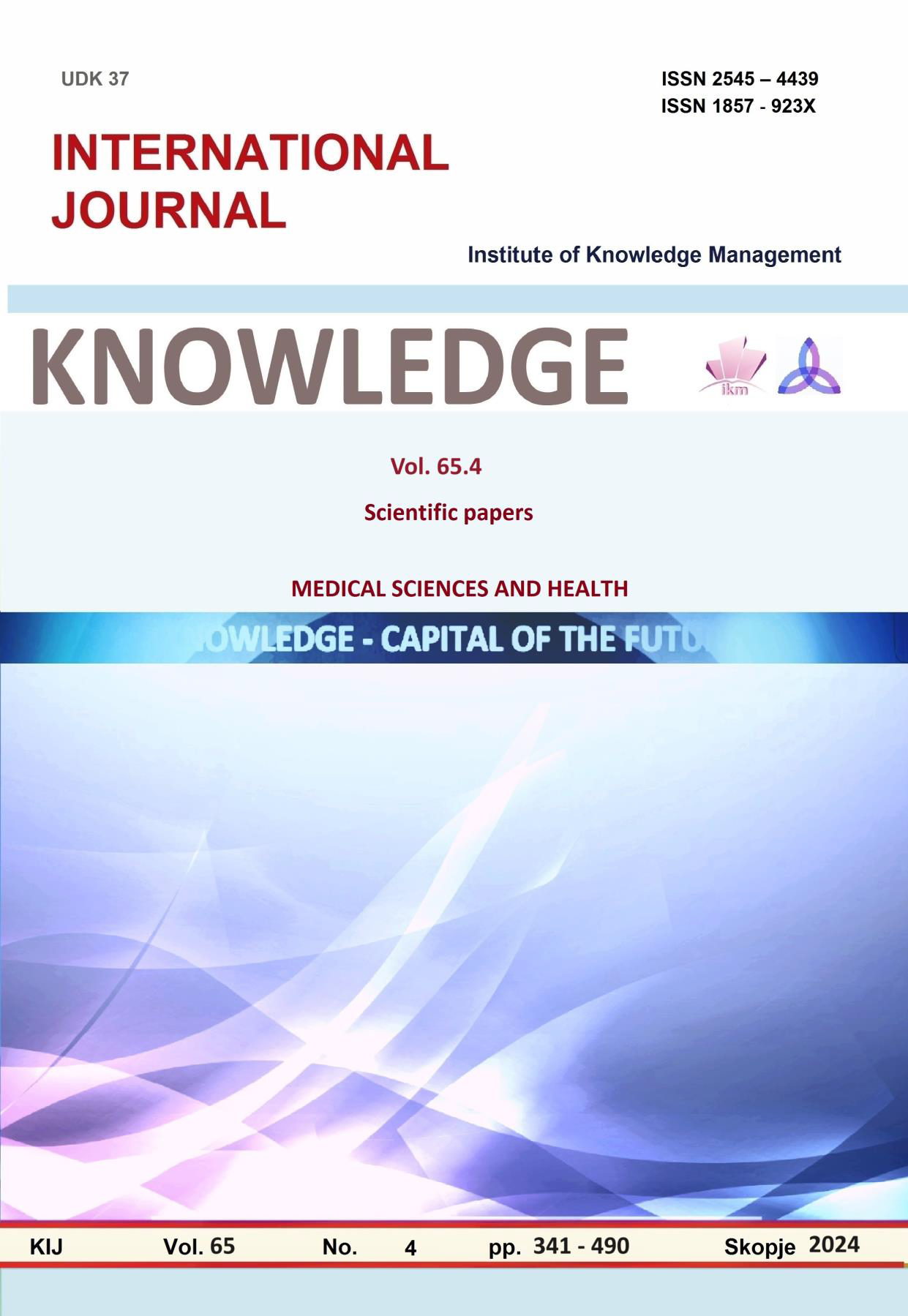DENTAL AND OCCLUSAL CHARACTERISTICS IN PATIENTS WITH IMPACTED
Abstract
Impacted teeth, retained are fully formed teeth, but with delayed eruption time on their own or elsewhere in the dental arch or outside of it, based on clinical and radiographic assessment.
Objective: To determine the dental and occlusal characteristics in patients with impaction of the maxillary canines.
Materials and methods: Orthodontic study models from 60 male and female subjects aged 11 to 18 years with unilateral and bilateral impaction of maxillary canines were used. The control group for gnathometric analysis consisted of 60 subjects with normally erupted maxillary canines of the same age. The following parameters were measured on the models of the subjects and the control group: Palatal index (palate depth), Overjet (oj), Overbite (ob), and Dent-alveolar intermaxillary relationship based on incisal classification: I incisal, II/I, II/II, and III incisal class.
Results: Among the patients in the study group, 36.7% had an impacted maxillary canine 13, and 21.7% had an impacted maxillary canine 23. Bilateral impaction of maxillary canines 13 and 23 was present in 41.7%. Unilateral impaction of maxillary canines was recorded in 58.4% of the study group. A significant association was found between bilateral/unilateral impaction versus the side of buccal/palatal impaction for p<.05 (Pearson Chi-square: 10.8225, p=.001003). No significant association was found between bilateral/unilateral impaction versus gender for p>.05 (Pearson Chi-square: 2.19429, p=.138523). A significant correlation was recorded between genders versus the registration of impacted maxillary canines (Chi-square: 4.1262, p=.0422247). A significant difference was confirmed between the average age of subjects with unilateral and bilateral impaction (Mann-Whitney U Test, p=0.007947). According to the Mann-Whitney U Test, the difference in average values of the palatal index (palate depth) between the two groups was not significant for p>.05 (Mann-Whitney U Test, p=.068566). According to the Mann-Whitney U Test, the difference in average values of overjet (oj) or horizontal incisal distance between the two groups was not significant for p>.05 (Mann-Whitney U Test, p=.140956). According to the Mann-Whitney U Test, the difference in average values of overbite (ob) or vertical incisal distance between the two groups was not significant for p>.05 (Mann-Whitney U Test, p=.719198). No significant correlation was recorded between dentoalveolar intermaxillary relationship based on incisal classification and membership in the two groups for p>.05 (Pearson Chi-square: 8.98978, p=.174154). Conclusion: In relation to the buccal/palatal impaction position, there is a significant association between bilateral/unilateral impaction. There is no significant association between bilateral/unilateral impaction in relation to gender. Female patients are twice as likely to develop impacted maxillary canines compared to male patients. The average age of patients with unilateral impaction is 15.2±2.2 years, while the average age of patients with bilateral impaction is 13.1±1.9 years. There is a significant difference in the mesiodistal dimensions of teeth 16, 13, 21, and 23 between the two groups studied. The total sum of the mesiodistal dimensions of the teeth is greater in patients with impacted maxillary canines. In the IG, the most represented depth of the palate is medium depth (28.0 - 39.9) at 55.0%, followed by shallow depth at 43.3%, and high depth (>=40.0) at 1.7%. There is no significant difference in the depth of the palate between the groups studied. There is no significant difference between the two groups regarding overjet and overbite. The majority of patients with impacted maxillary canines are in Class I incisal, with 36.7%.
References
Abdulraheem, S.; Alqabandi, F.; Abdulreheim, M.; Bjerklin, K.(2019).Palatally displaced Canines: Diagnosis and interceptive treatment. J. Orthod. Craniofac. Res. 1, 106 Alhammadi MS, Asiri HA, Almashraqi AA( 2018): Incidence, severity and orthodontic treatment difficulty index of impacted canines in Saudi population. J Clin Exp Dent. 10:e327 34. 10.4317/jced.54385
Alkadhimi AF, Ganesan K, Al-Awadhi E. (2017).Open or closed exposure for palatally impacted maxillary canines? A review. Ortho Update; 10(3): 102-110.
Al-Nimri K , Gharaibeh T (2005) Space conditions and dental and occlusal features in patients with palatally impacted maxillary canines: an aetiological study . European Journal of Orthodontics 27 : 461 – 465
Anic-Milosevic, S., Varga, S., Mestrovic, S., Lapter-Varga, M. and Slaj, M. (2009) Dental and Occlusal Features in Patients with Palatally Displaced Maxillary Canines. The European Journal of Orthodontics, 31, 367-373.
Alshawy E (2023) The Prevalence and Categories of Impacted Maxillary Canines: A Radiographic Study. Cureus 15(6): e40070. doi:10.7759/cureus.40070
Cruz RM.(2019). Orthodontic traction of impacted canines: Concepts and Clinical application. Dental Press J Orthod.; 24(1): 74-87.
Grybienė V, Juozėnaitė D, Kubiliūtė K.( 2019).Diagnostic methods and treatment strategies of impacted maxillary canines: a literature review. Stomatologija; 21: 3-12. - PubMed Hong W-H, Radfar R, Chung C-H. (2015). Relationship between the maxillary transverse dimension and palatally displaced canines: A cone-beam computed tomographic study. Angle Orthod. 2015;85:440– 5.
Hsu, Yu-Cheng; Kao, Chia-Tze; Chou, Chih-Chen; Tai, Wen-Ken; and Yang, Po-Yu (2019) "Diagnosis and Management of Impacted Maxillary Canines," Taiwanese Journal of Orthodontics: Vol. 31: Iss. 1, Article 1. DOI: 10.30036/TJO.201903_31(1).0001
Kaczor-Urbanowicz K, Zadurska M, Czochrowska E.(2016): Impacted Teeth : An Interdisciplinary Perspective. Adv Clin Exp Med.; 25(3): 575-585.
Mishe I. (1991) Oralna kirurgija. III izd. Zagreb: Medicinska naklada





